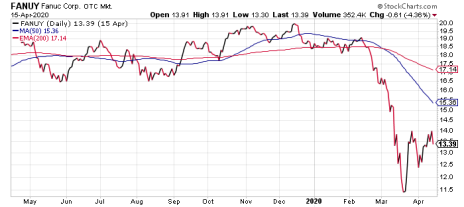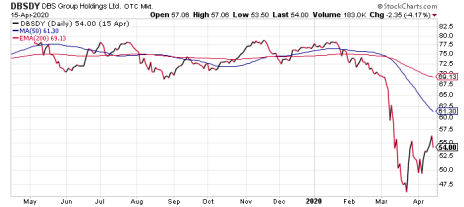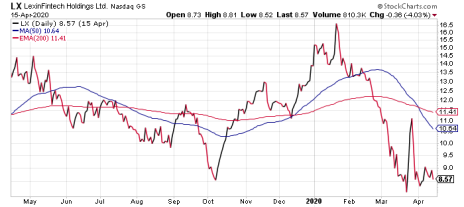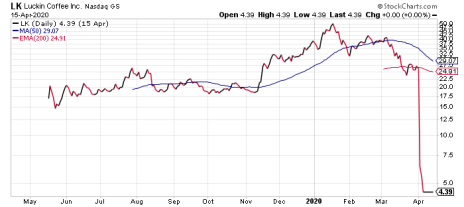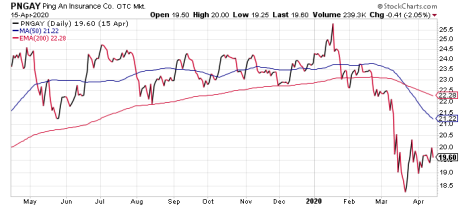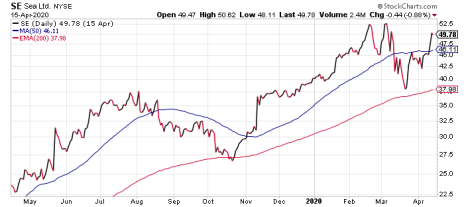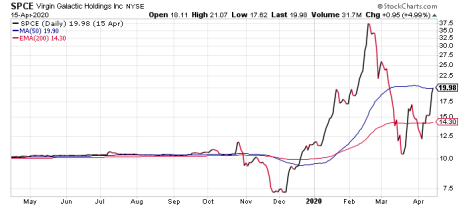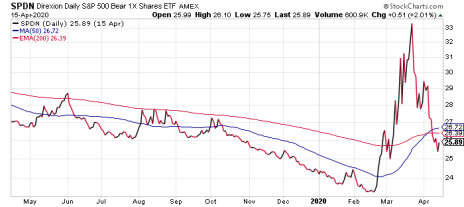The market rebound from its lows has been impressive as the unprecedented amount of stimulus injected by the Fed and Congress has overwhelmed any forward-looking concerns about the real economy.
The key now is to build, day by day, a more normal trading pattern. Cabot Global Stocks Explorer positions have kept pace with the market with outlier Virgin Galactic (SPCE) coming back 75% in two weeks. Our emerging markets (EEM) timer needs a bit more time to come out of its negative position. Today’s new recommendation is a high-quality, debt-free robot maker that is trading at close to a 10-year low.
Cabot Global Stocks Explorer 709
[premium_html_toc post_id="202728"]
Markets Rebound as Stimulus Overpowers Concerns About Real Economy
As encouraging as the recent market gains have been for investors with the S&P 500 up 25% from its March 23 lows, big daily moves are a hallmark of stressed markets. Over the past month, the Dow Jones Industrial Average had 28 swings - higher or lower - of at least 0.5%.
Putting the Fed stimulus aside, Congress has already approved new virus-related spending that, together with this year’s pre-virus budget deficit projection of $1 trillion, puts our budget deficit on a path to reach 20% of America’s GDP in one year.
This is big stuff. I hope it is enough because our average annual budget deficit since WWII has been 2% of GDP. Buy quality names selectively and incrementally from here with the assumption that there is going to be a steady run of negative headlines.
So in short, my read is that the huge stimulus measures have overpowered concerns about the real economy. This is why I’m keeping as a hedge a 10% position in our ETF that moves opposite the S&P 500 index.
Our emerging markets indicator (EEM) is in an uptrend but needs a bit more time to turn positive. There are still great names trading at attractive prices. Keep in mind that the EEM recovered from its last sharp pullback by rising 80% in two years, from early 2016 to early 2018.
China has been relaxing foreign ownership limits in the financial sector and JP Morgan now owns 100% of its Chinese mutual fund joint venture, marking another milestone for foreign ownership in the mainland’s financial sector. The U.S.-based bank said it has reached a deal with Shanghai International Trust (Shanghai Trust) to take a 100% ownership stake in China International Fund Management (CIFM).
China’s slowing economy and the U.S.-China tariff back and forth has cut China’s exports to the U.S. but Vietnam has grabbed by far the lion’s share of that market void. Of the $31 billion in U.S. imports that shifted from China to other Asian low-cost countries, almost half was absorbed by Vietnam, which exported $14 billion more manufactured goods to the U.S. in 2019 than it did in 2018, according to a study by the consulting firm Kearney.
Our Cabot Global Stocks Explorer recommendations have generally rebounded with the market, some more strongly than others. Sea Limited (SE) has demonstrated relative strength while British Petroleum (BP) has been moved to a sell given the likelihood of protracted low oil prices. I have an extensive update on Luckin Coffee (LK), which is in a trading halt, in the below portfolio section.
New Explorer Recommendation: Fanuc (FANUY)
Robots Making Robots - in Japan and Around the World
While you have seen a multitude of stories about the rise of robots in manufacturing as well as everyday life, you may not be aware of Fanuc (FANUY), a Japanese blue chip with zero debt, a sterling reputation, and a storied past.
Headquartered in the shadow of Mount Fuji, Fanuc is the world’s leading manufacturer of computerized numerical control (CNC) devices that are used in machine tools and also serve as the “brains” of industrial robots. Fanuc claims to be the only company that uses robots to make robots.
Fanuc, whose name is an acronym for Fuji Automatic Numerical Control, has been a world leader in robotics since the early 1970s. It was founded as a wholly owned subsidiary of Fujitsu in 1955 after that electronics giant decided to enter the factory automation business.
Today Fanuc is as global as it gets with over 240 joint ventures and offices in over 46 countries with a commanding 65% share of its world market. For example, industrial robot manufacturer Shanghai-Fanuc Robotics Co. Ltd. has a plant in Shanghai’s Baoshan district.
Fanuc should benefit from robust demand from developed markets as well as China as its manufacturing wages continue to increase and manufacturers look to robots to increase productivity. You can find Fanuc robots at Amazon warehouses as well as the shop floor of General Motors.
Will robots replace manufacturing workers is a common question you here at cocktail parties these days (well, maybe not these days, but back when cocktail parties were allowed before this global pandemic hit). I’m sorry to say they already are. Use of industrial robots has allowed companies like Panasonic to run factories that produce 2 million plasma television sets a month with just 25 people
Much of the company’s sales are channeled through GE Fanuc, a 50-50 automated machinery joint venture with General Electric Company. Fanuc does most of its manufacturing in Japan, and is building a new factory near Tokyo to double its domestic output capacity of machine tools to produce parts of smartphones.
I have been following Fanuc’s stock for some time but it always seemed expensive.
With the pullback in the market, now is a great entry point as the stock is trading just over 13, the lowest in a decade, and down from a 52-week high of 19.
Fanuc offers investors a pristine balance sheet with zero debt and a whopping $7 billion in cash. Profit margins are impressive and Fanuc also bought back 72 million shares last month. In short, Fanuc is a high-quality play on what seems to be an unstoppable trend. BUY A HALF POSITION
Model Portfolio
| Stock | Price Bought | Date Bought | Price 4/15/20 | Profit | Rating |
| Alibaba (BABA) | 102 | 1/27/17 | 208 | 104% | Buy |
| British Petroleum (BP) | 25 | 3/9/20 | 23 | -9% | Sell |
| DBS Bank (DBSDY) | 50 | 4/2/20 | 54 | 7% | Buy a Half |
| Direxion S&P 500 Bear (SPDN) | 26 | 3/5/20 | 26 | 1% | Buy to 10% |
| Fanuc (FANUY) | New | — | 13 | — | Buy a Half |
| JP Morgan (JPM) | — | — | 91 | — | Drop |
| LexinFintech (LX) | 13 | 2/6/20 | 8.57 | -36% | Buy a Half |
| Luckin Coffee (LK) | 18 | 6/13/19 | 4.39 | -76% | Hold |
| Ping An (PNGAY) | 24 | 1/9/20 | 20 | -19% | Buy |
| Sea Limited (SE) | 15 | 2/8/19 | 50 | 235% | Buy a Half |
| Virgin Galactic (SPCE) | 7.34 | 12/5/19 | 20 | 172% | Buy a Half |
Portfolio Changes
British Petroleum (BP) MOVE FROM BUY A HALF TO SELL
JP Morgan (JPM) IS REMOVED FROM THE WATCH LIST
Updates
Alibaba (BABA) shares were up another 5% in the past week, going from 196 to 208.
A number of investment banks have confirmed or upgraded buy recommendations for BABA. For example, KeyBanc maintains an “Overweight” rating on Alibaba and raised the price target from 248 to 255 based on expected sales momentum.
BABA’s revenue for last quarter’s core commerce business revenue increased 38% while Lazada (its Southeast Asian e-commerce business) posted a 97% year-over-year increase and Alibaba’s cloud segment increased revenue by 62% year-over-year. Tmall Global, which imports products from international brands, saw growth of 45%. This is all impressive for a company the size of Alibaba.
BABA is a great China core holding for those looking for exposure to the rising Chinese consumer class. For longer-term investors, I would be a buyer at these levels. BUY A FULL POSITION
British Petroleum (BP) shares retraced to 23 this past week, as the OPEC deal firmed up crude prices a bit but most forecasts see weak prices through most of 2020.
I believe we may get another crack at BP later in the year so to raise some cash and keep our loss on this to a minimum, I’m moving BP to a sell. MOVE FROM BUY A HALF TO SELL
DBS Bank (DBSDY) added 6% this week, reaching 54 despite some weakness yesterday.
DBS is one of the largest banks in Southeast Asia with a presence in 18 markets. It is headquartered in Singapore, with its main listing on the Singapore Stock Exchange, and is the largest constituent of the Singapore Straits Times Index.
The Government of Singapore established DBS in July 1968 and its largest and controlling shareholder is Temasek Holdings, which is one of two large sovereign wealth funds controlled by the Government of Singapore.
DBS has a growing presence in the three key Asian areas of growth, which it defines as Greater China, Southeast Asia, and South Asia, meaning India.
It is the largest and strongest bank in Southeast Asia and the leading consumer bank in both Hong Kong and Singapore.
Its tentacles reach out through 200 branches in 50 cities. DBS produces steady profit margins, revenue, and earnings and is also increasing market share in consumer and corporate banking. Wealth management is also a strategic priority and a growing part of its business.
Why buy DBS right now? The stock has come back from a 52-week high of 93 to trade at just below 50—its lowest price since 2016.
It’s now up to 54. But I encourage you to buy DBS at these levels. BUY A HALF
LexinFintech (LX) shares advanced only marginally this week, closing at 8.55.
In its last quarter, LX loan volume was up 104% year-on-year and LX’s continued investment allowed for our registered user numbers to increase 96.5% year-on-year and new active users increased 244%.
Based in Shenzhen, LexinFintech is an online consumer finance platform for young adults in China. The company owns and operates Fenqile, a popular online consumer finance platform that offers installment loans and also matches borrowers with lenders.
LX sells for between 8-9 times prospective earnings. LexinFintech earned almost $2 a share in 2019 and that number could potentially grow by 50% or more in 2020.
I believe LX offers us an excellent risk-reward opportunity and recommend you buy LX if you have not yet done so. Please put in place a 25% trailing stop loss for this aggressive idea. BUY A HALF
Luckin Coffee (LK)’s stock trading has been halted at a price of 4.39 pending further information.
Keep in mind that that the coffee chain’s unit expansion story is not impacted by this financial fiasco. The company didn’t overstate the number of stores it has opened and Luckin has still gone from nine coffee houses at the end of 2017 to 4,500 at the end of 2019.
In the statement issued regarding the scandal on April 3, Luckin Coffee suggested that both operating expenses and revenue were inflated.
A complicating factor is that a substantial amount of Luckin shares were put up as loan collateral, resulting in a block of shares going to Goldman Sachs. Goldman is apparently holding a substantial position and may be seeking clarification on accounting issues or looking to place the stock with another firm.
Uncertainty is high and the near-term range of possibilities include: 1) trading is resumed with more information regarding the financial and accounting status of the company, 2) the possibility of Luckin being acquired, 3) the delisting of Luckin, whereby it may make an offer to shareholders prior to delisting and trading over-the-counter, or 4) bankruptcy.
This is a very unfortunate situation that we need to deal with the best we can.
Luckin attracted major investors such as BlackRock and Singapore’s sovereign wealth fund even before it went public last May at 17, and in the last year rose sharply to a high of 51 on January 17, making it one of the Explorer’s best-performing stocks. I advised multiple times selling a part of the LK position to lock in profits, though not the whole thing.
A special committee has been formed to oversee the investigation and to recommend appropriate actions against the perpetrators.
A restatement to the financial reports published in 2019 is now certain. For instance, the company had $775 million in cash and liquid investments at the end of September 2019, which I believe will be used to scale up the company.
We’ll see what happens next. Until then, I suggest you sit tight if you still own LK shares. HOLD
Ping An (PNGAY) shares continue to underperform on a relative basis, which is puzzling given its quality and solid financial results.
Ping An provides financial products and services for insurance, banking, and asset management but is best known for its life, health and property insurance business.
Ping An is a dominant player in this space with over 200 million retail customers and ranked 29th on the Fortune Global 500 list. The latest numbers for the company are encouraging: last quarterly earnings were up 49.7%, the company delivers a 24% return on equity and the stock is only trading at eight times trailing earnings and seven times projected earnings.
Ping An is in the top 10 in the Global 500 2020 rankings released by the leading brand valuation consultancy Brand Finance, climbing five places to number nine among global brands. It ranked first among global insurance peers and second among global financial peers.
This stock has held up very well despite all the turbulence, and I recommend you buy a full position if you have not already done so. BUY A FULL POSITION
Sea Limited (SE) shares were up 10% this week and appear back on track.
The company released of its quarterly and full-year financials a few weeks ago with adjusted revenue of $909 million, up 133.5% year-on-year from the fourth quarter of 2018.
Sea Ltd’s Shopee Mall, the largest Southeast Asian e-commerce platform by orders, continues to see healthy growth in stores ahead of peers in ASEAN – online stores in Indonesia have grown by 30% in three months. Our analysis indicates widespread mall and store closures in ASEAN. Prolonged store closures could support adoption of e-commerce.
Sea’s self-developed global hit game, “Free Fire”, was the most downloaded mobile game globally in 2019, according to App Annie, and recently hit a new record of 60 million peak daily active users. “Free Fire” was also the highest grossing mobile game in Latin America and in Southeast Asia in the fourth quarter and for the full year of 2019.
Adjusted revenue for digital gaming was $479.9 million, up 107% year-on-year.
Quarterly active users reached 354 million, an increase of 64% year-on-year.
All indications point to Sea having the potential to be an enduring growth stock. BUY A HALF
Virgin Galactic (SPCE) shares were up 33% this past week and have snapped back 75% in the last two weeks.
The company announced that it plans to report its financial results for the first quarter 2020 following the close of the U.S. markets on May 5. Morgan Stanley came out recently with a buy rating, valuing SPCE’s space tourism business at 14 a share and the hypersonic flight opportunity at 10 a share, to arrive at a current composite target price of 24.
SPCE still plans to make its first commercial space-tourism flight this year, and took a step toward resuming ticket sales for jaunts expected to cost upward of $250,000. The company said on an investor call Tuesday it was focused on working through testing and approval for its space launch system.
More than 600 potential customers have already paid a collective $80 million in deposits for the flight and the company has in its sales funnel 2 million prospects with liquid assets of $10 million or more. Furthermore, beyond space tourism, the company is taking dead aim at a global commercial aviation market worth $900 billion and could potentially land some defense contract. Those would include a proposed hypersonic jet that could in theory travel from London to New York in an hour.
Boeing last year invested $20 million in the company and its CEO, George Whitesides, said the company was focused on commercial launch and had completed 20 of the 29 approvals required to validate the commercial license it received from the Federal Aviation Administration in 2016.
I would be a bit more cautious after this run-up, buying on dips. BUY A HALF
Direxion Daily S&P 500 Bear (SPDN) fell from 26 to 25 this week.
The SPDN is an exchange-traded fund (ETF) that moves opposite (inverse) of the S&P 500 index. It serves as a portfolio shock absorber and as the market has rallied it’s fallen from a high of 33 on March 23 to 25 now. Unless you have strong conviction that the market will not test its recent lows I advise keeping a small SPDN position in your portfolio. BUY 10% POSITION
The next Cabot Global Stocks Explorer issue will be published on April 30, 2020.
Cabot Wealth Network
Publishing independent investment advice since 1970.
CEO & Chief Investment Strategist: Timothy Lutts
President & Publisher: Ed Coburn
176 North Street, PO Box 2049, Salem, MA 01970 USA
800-326-8826 | support@cabotwealth.com | CabotWealth.com
Copyright © 2020. All rights reserved. Copying or electronic transmission of this information is a violation of copyright law. For the protection of our subscribers, copyright violations will result in immediate termination of all subscriptions without refund. No Conflicts: Cabot Wealth Network exists to serve you, our readers. We derive 100% of our revenue, or close to it, from selling subscriptions to its publications. Neither Cabot Wealth Network nor our employees are compensated in any way by the companies whose stocks we recommend or providers of associated financial services. Disclaimer: Sources of information are believed to be reliable but they are not guaranteed to be complete or error-free. Recommendations, opinions or suggestions are given with the understanding that subscribers acting on information assume all risks involved. Buy/Sell Recommendations: All recommendations are made in regular issues or email alerts or updates and posted on the private subscriber web page. Performance: The performance of this portfolio is determined using the midpoint of the high and low on the day following the recommendation. Cabot’s policy is to sell any stock that shows a loss of 20% in a bull market or 15% in a bear market from the original purchase price, calculated using the current closing price. Subscribers should apply loss limits based on their own personal purchase prices.

